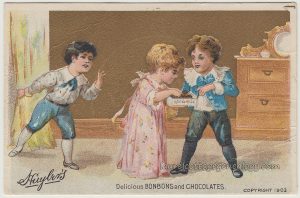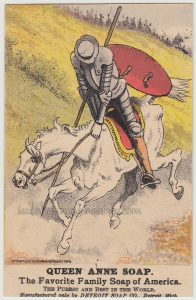Trade Card for Celluloid Collars and Cuffs. Circa 1878 – 1880s.
Price: $7.00 Size: About 4 x 2 and 1/2″
Frog and gnome-like (for lack of a better description, I know, where’s the beard? Maybe a young gnome 😉 ) character advertising Celluloid collars, cuffs and shirt bosoms. This trade card was one of a set of six. Very charming, especially when viewing the whole series. Here’s a crop from a Google image search showing the others:
Our frog and gnome card is the second one we have for Celluloid collars and cuffs. See also, B. J. Stone Trade Card, New Haven, CT.
A trade name
The term Celluloid was a trade name registered in the United States in 1873, and was used in a variety of applications, including hairbrushes, toys, billiard balls, ping-pong balls and the film industry. See the Encyclopedia Britannica’s article: “Celluloid: Synthetic Plastic.” The collars and cuffs were linen, covered with celluloid on the front and back to make them waterproof, thus drastically cutting the high cost of cleaning, and letting the wearer sidestep the “wilted look” in hot weather. Below, the earliest advertisement we found, which appeared in The Brooklyn Daily Eagle (June 13, 1878).
Another early-ish ad below, this one from The Star Democrat, February 24, 1880 indicating Celluloid collars and cuffs had newly arrived to Easton, Maryland.
And, hundreds of thousands of ads and related articles can be found late 1870s – 1910s and beyond, but at some point Celluloid collars and cuffs started to fall out of favor. When is a good question, but probably at least by the mid-1890s. Their use came to be associated with outmoded fashion, and a need for thriftiness. (The history of celluloid is book subject matter and much too detailed to research here.) Below, a short glimpse from 1910, into the life of a chap called Folsom Peverill (possibly a made-up name) that appeared in the The Topeka Daily Capital.
Last, but certainly not least, there were reports of high flammability, accidents where people were injured or even killed, in wearing Celluloid covered items or using objects made from the material (like hair combs). Some attribute some of these stories to urban myth, however, certainly there were instances of factory fires, which were always a threat, in general. Below, a report, from 1910, that lends credibility to the reports of the dangers of wearing Celluloid covered items. This ad was run in a number of U.S. papers, including The Sedalia Democrat.
Sources: “Wear celluloid collars and cuffs trade cards frog” Google image search. Google.com. (accessed August 24, 2017).
“Celluloid: Synthetic Plastic.” Encyclopedia Britannica. (accessed August 24, 2017).
“Celluloid Collars and Cuffs.” The Brooklyn Daily Eagle (Brooklyn, NY). June 13, 1878. Thursday, p. 1. (Newspapers.com).
“Something New Under the Sun!” The Star Democrat (Easton, MD). February 24, 1880. Tuesday, p. 3. (Newspapers.com).
“Time works great changes.” The Topeka Daily Capital (Topeka, KS). June 16, 1910. Thursday, p. 4. (Newspapers.com).
“Ban on Celluloid in Theaters.” The Sedalia Democrat (Sedalia, MO). January 7, 1910. Friday, p. 9. (Newspapers.com).







































